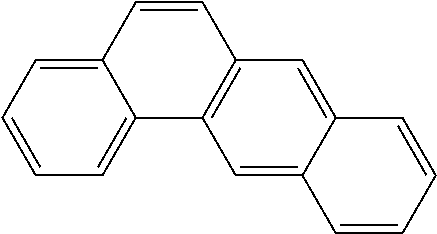Extraction of harmful compounds from materials containing such harmful compounds
a technology of harmful compounds and materials, applied in the field of dissolution, extraction, removal and/or reduction of harmful compounds from materials containing harmful compounds, can solve the problems of affecting the health of people, the health of animals, the environment, and the materials from which humans come, and the chemical compounds found in consumer goods, etc., to achieve the effect of reducing the risk of cancer
- Summary
- Abstract
- Description
- Claims
- Application Information
AI Technical Summary
Benefits of technology
Problems solved by technology
Method used
Image
Examples
example 1
f Harmful PAHs—Test 1
[0115]Crumb rubber samples were tested according to the EPA 8270D method for removal of PAHs by an independent NELAP accredited laboratory. For PAH level determination, the samples were subjected to 3 minute ultrasonic extraction with methylene chloride at room temperature and then the levels of PAHs were obtained using GC-MSD. As a control, a sample of untreated crumb rubber was found to contain:
[0116]
Name of PAHConcentration (mg / kg)AcenaphtheneBRLAcenaphthylene0.105AnthraceneBRLBenzo[a]anthraceneBRLBenzo[a]pyreneBRLBenzo[b]fluorantheneBRLBenzo[ghi]peryleneBRLBenzo[k]fluorantheneBRLChrysene0.237Dibenzo[a,h]anthraceneBRLFluoranthene0.625FluoreneBRLIndeno[1,2,3-cd]pyreneBRLNaphthalene0.092Phenanthrene0.45 Pyrene1.76 TOTAL3.269Detection (Reporting) Limit0.083BRL = Below Reporting Limit
[0117]Crumb rubber was mixed with a blend of turpentine fluids containing α-terpineol, β-terpineol, and β-pinene at 90° C. for 20 minutes. The crumb rubber was then separated from th...
example 2
f Harmful PAHs—Test 2
[0118]A different batch of crumb rubber samples from those tested in Example 1 was tested according to the ZEK method for removal of PAHs by the same independent NELAP accredited laboratory as in Example 1. For PAH level determination, the samples were subjected to 1 hour ultrasonic extraction with toluene at 60° C.
[0119]A first test sample of crumb rubber was mixed with a blend of turpentine fluids containing α-terpineol, β-terpineol, and β-pinene at 90° C. for 20 minutes. A second test sample of crumb rubber was mixed with a blend of turpentine fluids containing α-terpineol, β-terpineol, and β-pinene at 120° C. for 60 minutes. For each sample, crumb rubber was then separated from the turpentine fluids blend and was tested by the same ZEK method. The concentrations of PAHs in a sample of crumb rubber before and after treatment are tabulated below. As is clear from the data, no detectable concentration of any of the PAHs was found in either treated sample.
[0120]...
example 3
f Harmful PAHs—Test 3
[0121]A different batch of crumb rubber samples from those tested in Examples 1-2 was tested according to the ZEK method for removal of PAHs by the same independent NELAP accredited laboratory as in Examples 1 and 2. For PAH level determination, the samples were subjected to 1 hour ultrasonic extraction with toluene at 60° C.
[0122]A first test sample of the crumb rubber was mixed with a blend of turpentine fluids containing α-terpineol, β-terpineol, and β-pinene at 90° C. for 20 minutes. A second test sample of crumb rubber was mixed with a blend of turpentine fluids containing α-terpineol, β-terpineol, and β-pinene at 120° C. for 60 minutes. For each sample, crumb rubber was then separated from the turpentine fluids blend and was tested by the same ZEK method. As is clear from the table below, no detectable concentration of any of the PAHs was found in either treated sample.
[0123]
Concen-Concen-trationtrationConcen-(mg / kg)(mg / kg)trationAfterAfter(mg / kg)Treatment...
PUM
| Property | Measurement | Unit |
|---|---|---|
| temperature | aaaaa | aaaaa |
| temperature | aaaaa | aaaaa |
| temperature | aaaaa | aaaaa |
Abstract
Description
Claims
Application Information
 Login to View More
Login to View More - R&D
- Intellectual Property
- Life Sciences
- Materials
- Tech Scout
- Unparalleled Data Quality
- Higher Quality Content
- 60% Fewer Hallucinations
Browse by: Latest US Patents, China's latest patents, Technical Efficacy Thesaurus, Application Domain, Technology Topic, Popular Technical Reports.
© 2025 PatSnap. All rights reserved.Legal|Privacy policy|Modern Slavery Act Transparency Statement|Sitemap|About US| Contact US: help@patsnap.com



